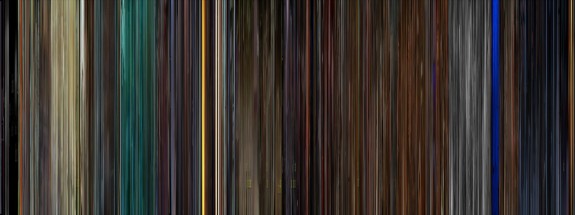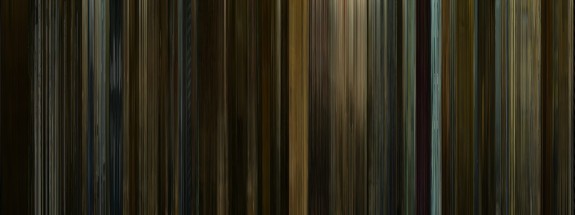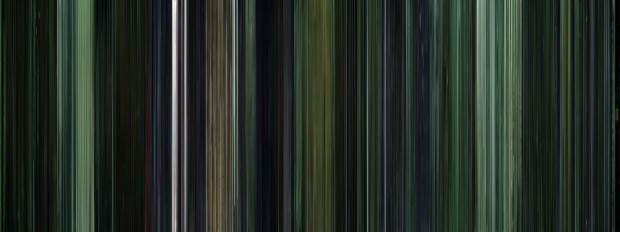Choice of color in a movie can say a lot about what’s going on in a scene. It sets the mood, changes the tone, indicates a change in point of view, so on and so forth, which is why moviebarcode is so fun to click through. The concept is simple. Take every frame in a movie and compress it into a sliver, and put them next to each other. Voilá. Movie barcode.
The above is The Matrix, making it obvious when they’re in and out of the system. Below are Kill Bill and The Social Network, respectively.


See dozens more on the moviebarcode tumblr, which is also selling these as prints.
[moviebarcode via @mslima]



Although people can come up independently with this idea, maybe it’s good to give the guy credit who first came up with this, 10 years ago: Jason Salavon.
Here are some examples:
http://salavon.com/MTVsTop10/MTVsTop10.shtml
http://salavon.com/TGFAT/Titanic.shtml
Thanks, Steeph. I knew I had seen something like this a few years ago, but I couldn’t put my finger on it.
Thanks Steeph. I clicked over from the google reader feed to post the exact same thing
I had him as a professor for a digital art class that covered a lot of things relevant to this blog…particularily renderings of data in Processing
Here are a couple others:
http://salavon.com/Emblems/Emblem_1.shtml
This one: http://salavon.com/AmVar_Census/AmVar_Census.php
is from a commission for the Census Bureau. Obviously, his work as an artist is more on the artistic side than the data visualization side (this one is based on county population data…but it is certainly not a tufte-compliant representation of the data)
makes for a great PC wallpaper :)
I have a book by Brendan Dawes who, I thought, came up with this technique: http://www.brendandawes.com/
Saw him present at FlashForward 2006 in Austin, Texas
The earliest I saw something like this was at a presentation by someone (I don’t recall the name) from Interval Research, around 1994 or 1995. I was working at Asymetrix on digital video editing software at the time. Both Asym and Interval were Paul Allen companies, and we (the tools folks at Asym) occasionally got some cross-pollenation from the research labs at Interval.
The application was fast scene selection and “video scrubbing” via slices like this–once you compress frames like this, it’s easy to visually cut and paste scenes. The researcher showed how scene reordering could rewrite the plot of Terminator (similar to the faux trailers popular on YouTube nowadays).
interesting. I’ve used similar techniques myself to visualise editing cuts in TV programs, although the technique was well established long before I tried it.
There’s an interesting parallel here with slit-scan photography. Flong.com has an interesting roundup of similar projects (mostly photographic, but some are pretty abstract).
http://www.flong.com/texts/lists/slit_scan/
Interesting to see how dark a lot of the movies look…
Shame that the interface does not allow collaborative annotation, it would attract droves of users and make the vizzes way more meaningful
I prefer my version :)
http://yeahmacht.com/analyzing-movies/
I love the movie barcodes!
When and Where can I download the app that uncompresses the barcode and plays the movie on my Android or other mobile device? :-)
it seems a freaky work, but when you think deeper about it, it is a very good chromatic representation of the film. you can imagine the different scenes that compose it. great!
I love that Uma Thurman’s yellow suit turns up throughout Kill Bill’s color barcode